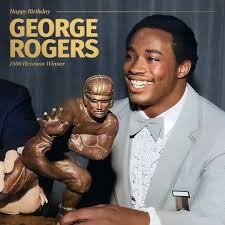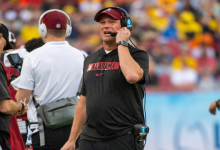Heisman Trophy Winner George Rogers on his life and career

George Rogers, the 1980 Heisman Trophy winner and University of South Carolina football legend, is a name that is synonymous with excellence on the football field. With his dominant performances, unparalleled work ethic, and commitment to success, Rogers not only redefined what it meant to be a running back in college football but also left an indelible mark on the sport itself. In this reflection on his life and career, Rogers shares insights into the journey that led him to Heisman glory, the challenges he faced, and the impact he made at South Carolina and beyond.
Born on December 8, 1958, in Duluth, Georgia, George Rogers came from humble beginnings. Raised by his aunt, Rogers grew up in a challenging environment that was marked by financial hardship. His father was incarcerated, and his mother was not a consistent presence in his life. Despite these obstacles, Rogers found solace and purpose in sports, particularly in football.
As a child, Rogers exhibited a natural athletic ability that would eventually propel him into stardom. At Duluth High School, he was a multi-sport athlete, excelling not only in football but also in track and field. However, it was on the football field where Rogers truly shined. His combination of size, speed, and agility quickly caught the attention of college recruiters. By the time he graduated from high school, Rogers had established himself as one of the top running back prospects in the country, setting school records and earning numerous accolades for his performances.
In 1977, George Rogers decided to take his talents to the University of South Carolina, where he would embark on a college football journey that would make him a household name. At 6’2″ and 220 pounds, Rogers was a physical specimen who had the ability to overpower defenders while also demonstrating impressive agility and speed for his size.
During his first year at South Carolina, Rogers showcased his potential, rushing for 1,000 yards as a freshman. His success as a first-year player set the tone for what was to come. By the time he completed his college career, Rogers had set multiple school records, including the most rushing yards in a single season and the most career rushing touchdowns.
But it wasn’t just his raw talent that set Rogers apart; it was his relentless work ethic and determination to succeed. He had a never-give-up attitude that pushed him to perform at a consistently high level. His leadership on and off the field earned him the respect of his teammates, coaches, and fans alike.
Rogers’ junior season (1980) was one for the ages. He rushed for 1,781 yards and 14 touchdowns, leading the nation in both categories. Rogers’ ability to break tackles, outrun defenders, and carry the ball with power made him a matchup nightmare for opposing teams. He gained over 100 yards in 11 of South Carolina’s 12 games, cementing his place as one of the top running backs in college football.
The highlight of Rogers’ 1980 season came when he won the prestigious Heisman Trophy, becoming the first South Carolina player ever to receive the honor. His victory over competitors like Georgia’s Herschel Walker and Pittsburgh’s Hugh Green solidified his status as a college football legend.
In reflecting on that season, Rogers remembers the hard work and determination it took to get to that point. “It was a culmination of everything I worked for in my life,” he says. “Winning the Heisman was something I dreamed about, but it didn’t happen overnight. It took years of dedication, sacrifice, and a lot of support from my teammates and coaches.”
Despite the attention and accolades, Rogers remained grounded, always crediting his success to the people around him and the system that helped him flourish. South Carolina’s offensive line, coaching staff, and his supportive family were all integral parts of his achievement.
Following his illustrious college career, Rogers was selected as the first overall pick in the 1981 NFL Draft by the New Orleans Saints. While he had enjoyed immense success in college, he was about to face a new challenge in the NFL. The competition was tougher, and the stakes were higher, but Rogers was ready.
In his rookie season, Rogers made an immediate impact. He rushed for 1,674 yards and 13 touchdowns, earning the NFL Offensive Rookie of the Year award. His performance that season was remarkable, as he became one of the league’s premier running backs. Rogers played for the Saints for five seasons, becoming a fan favorite in New Orleans.
However, the most significant achievement of his professional career came when he was traded to the Washington Redskins in 1985. In Washington, Rogers became part of a Super Bowl-winning team, helping the Redskins capture the championship in Super Bowl XXII. The 1987 season saw Rogers return to the top of his game, as he rushed for over 1,000 yards and played a key role in the Redskins’ success. Although his time in the NFL was relatively short—lasting from 1981 to 1987—Rogers made a lasting impact on both the Saints and Redskins organizations.
While Rogers’ professional career was filled with achievements and accolades, it wasn’t without its challenges. He faced injuries and setbacks that limited his playing time and forced him to adapt to different systems. Despite these obstacles, Rogers never lost his love for the game and remained committed to doing whatever it took to succeed.
He notes, “Injuries were tough. They take a toll on your body, and when you’re a running back, it’s especially hard because you take a lot of hits. But I always tried to stay focused on the bigger picture—doing my best for my team and playing at the highest level possible.”
Off the field, Rogers also dealt with the pressures of being a public figure. The fame and attention that came with his Heisman win sometimes created personal challenges. However, Rogers credits his strong family support system and faith for helping him navigate these pressures.
After retiring from football, Rogers remained involved in the sport in various capacities, including working with the George Rogers Foundation, which helps provide financial support to underprivileged students pursuing higher education. Rogers has also stayed connected to the South Carolina football program, where his legacy is still celebrated. In 1997, he was inducted into the College Football Hall of Fame, cementing his place among the sport’s elite.
His No. 38 jersey was retired by South Carolina in 2015, and a statue of Rogers was erected outside of Williams-Brice Stadium, ensuring that future generations of Gamecock fans would remember his contributions to the program. In an era where college football is dominated by modern-day stars, Rogers’ name still holds great significance, especially in South Carolina, where he remains a beloved figure
Looking back on his life and career, George Rogers expresses gratitude and pride. “I’m grateful for everything I accomplished in football, but what I’m most proud of is the impact I had on people’s lives,” he says. “Whether it was my teammates, coaches, or fans, I always wanted to inspire others and show them that hard work pays off.”
Rogers’ influence extends beyond football. He is remembered for his community service, his commitment to helping others, and his role as a mentor to young athletes. Through his foundation, Rogers continues to provide opportunities for those who might not have access to higher education, ensuring that his legacy is not just about his achievements on the field but also the positive impact he has had on countless individuals.
George Rogers’ career is a testament to the power of determination, hard work, and passion. From his early days in Georgia to his record-breaking performances at South Carolina and his successful professional career in the NFL, Rogers has proven that greatness is attainable with the right mindset. His Heisman Trophy win and his lasting influence on the game of football will forever be part of college football history.
For the Gamecocks, Rogers is not just a football legend; he is a symbol of what it means to represent the University of South Carolina with pride and excellence. As he continues to inspire future generations, Rogers’ legacy will remain an enduring part of both South Carolina and college football lore.









